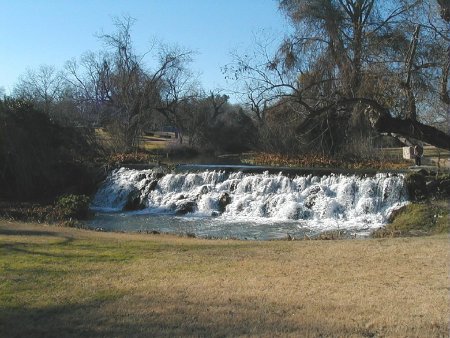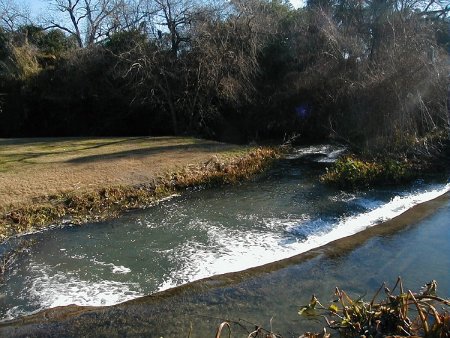Espada Dam
History:
Each one of the five principal missions located near the banks of the San Antonio River had a diversionary dam built near it. This type of dam interrupted the flow of water through the main river channel, diverting some of the water into an acequia, or irrigation ditch, dug off to one side above the dam. The acequia then carried water to the mission and the nearby farm fields.
The Espada dam and acequia are the only one of the five missions' waterways left intact, and they still carry water to irrigate fields. The three–mile long irrigation ditch, or acequia, flows from the river at the dam site, irrigating 400 acres of land, before flowing back into the river below Mission Espada. Spanish water laws required that all ditches dug away from the river returned to it.
The Franciscan priests and mission inhabitants built the dam and acequia sometime between 1731 and 1745. These structures have stood all these years with some periodic repairs and strengthening. It used to be said that the dam was built curving the wrong way – outward. But, now we know that statement is not true. The Spanish engineers often built dams curving outward as diversionary, rather than retention, dams. This is the only Spanish–built dam still existing in the United States.
The Espada dam and acequia are the only one of the five missions' waterways left intact, and they still carry water to irrigate fields. The three–mile long irrigation ditch, or acequia, flows from the river at the dam site, irrigating 400 acres of land, before flowing back into the river below Mission Espada. Spanish water laws required that all ditches dug away from the river returned to it.
The Franciscan priests and mission inhabitants built the dam and acequia sometime between 1731 and 1745. These structures have stood all these years with some periodic repairs and strengthening. It used to be said that the dam was built curving the wrong way – outward. But, now we know that statement is not true. The Spanish engineers often built dams curving outward as diversionary, rather than retention, dams. This is the only Spanish–built dam still existing in the United States.
About this Image:
1) The Espada dam, which is up the river (north) from the Espada aqueduct, causes water to pool in order to divert it into the acequia watering the mission lands. Photos taken by Ron Bauml.
2) A view taken from the top of the Espada dam.
2) A view taken from the top of the Espada dam.
Credit:
Courtesy of the San Antonio Conservation Society Foundation.


